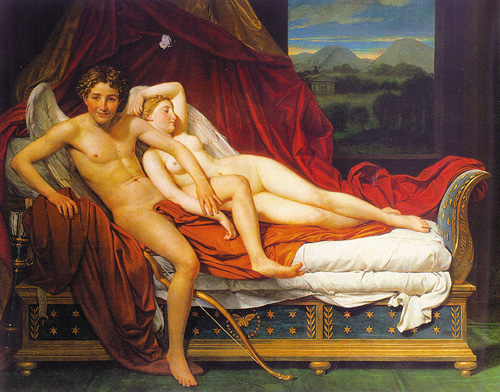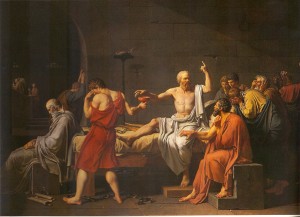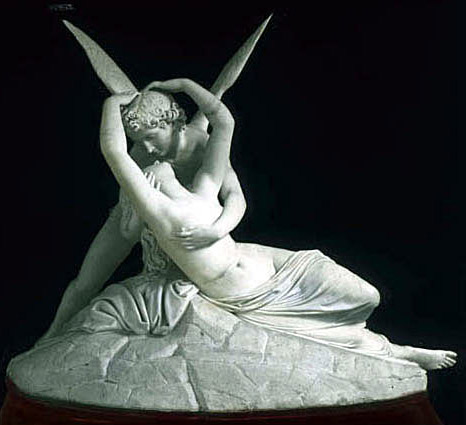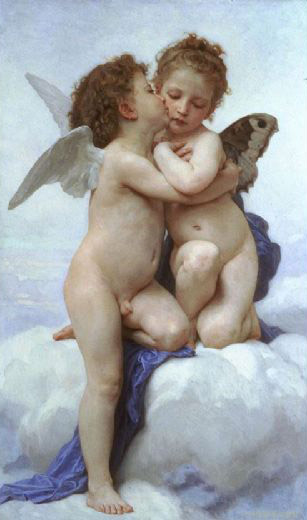
J. L. David’s Cupid and Psyche
Jacques-Louis David is one of my favorite artists. David’s reputation was cemented for me the first time I visited the Louvre.
David made a career revitalizing well-known stories and allegories. From the beginning of his career, David transformed shopworn subjects into works of startling originality. In David’s masterful hands, familiar themes, such as the Death of Socrates, attain drama that few have achieved.
In David’s large paintings based on history, myth, and legend, he simultaneously imparts a grandeur and intimacy that is unique.
The Cleveland Museum of Art owns one of David’s works on a well-known theme, Cupid and Psyche. Psyche and Cupid (or Amor or Eros) are among the most well-known characters from antiquity. Their oft-told story can be summed up briefly:
Cupid, busy with his usual mischief, is sent by the jealous goddess Venus to punish the young maiden, Psyche, for being more beautiful than Venus herself. But Cupid falls in love with the girl instead and plots to have Psyche for himself. Through subterfuge and other plot twists, Psyche ends up isolated and alone when a stranger, Cupid, comes to her at night. Careful not to reveal his identity (for fear of Venus), he convinces the maid to accept him. So begins a happy period during which Cupid visits Psyche every night and leaves before dawn before Psyche can discover his identity. Psyche comes to look forward to the visits and longs to know the identity of the mysterious visitor.
With the help of her jealous sisters, Psyche lays a trap for the visitor and sees him for the first time. She immediately falls deeply in love. But Cupid, outraged at the subterfuge, flees. This begins a period of suffering and trial for the lovesick Psyche as she tries to find her lost love. After many trials and tribulations, the two are reunited after Cupid brokers a deal with Jupiter. Cupid promises to leave off his adultery-making mischief whenever Jupiter needs him to procure a girl for him. Cupid and Psyche live happily ever after. Their son is named Voluptas–‘pleasure.’
This story has been told since ancient times in many ways by artists, poets, and playwrights. It fascinates us because it combines eroticism with innocence and thus becomes the perfect metaphor for love. It was a trendy theme during David’s lifetime. David’s contemporaries frequently emphasized the erotic aspects of the tale. David’s contemporary Canova sculpted the magnificent erotic masterpiece Psyche Revived by Cupid’s Kiss in 1793, 24 years before David addressed the subject in 1817.
As the 19th century progressed, artists deemphasized the erotic. By the time Bouguereau painted this treatment, Cupid and Psyche represent innocent, child-like love. This is an especially saccharine and sentimental rendition. Bouguereau is a painter of immense power, but paintings like this one downgrade his reputation for me. (Don’t get me wrong, he’s a much greater artist than the Undergrad’s Big Book of Art History will have you believe, but even in his best work, he’s no David.)
In Cupid and Psyche, David’s many virtues are displayed in abundance. His style, as always, is straightforward and efficient. The play of light and form is a delight to the eye. As a formal design, the painting is very strong. As always in David’s paintings, the details do not detract from the overall theme.
Now, after heaping praise on David, I have to admit that this painting falls below his usual standard. In a too-close imitation of Titian, a landscape punctuates the narrow space and lets air into the narrow room. Air but no light. The figures are encased in an interior space, making the timidly painted (for David) landscape uninteresting. It appears to be an afterthought, which is shocking given how thoughtful and confident his designs normally are.
More serious, in this instance, David’s originality leads him astray. Here we see Cupid as a smarmy, smug teenager smirking over his conquest and ready to snap a selfie. Cupid once again escapes punishment at the hands of Venus or (perhaps worse!) Psyche’s father and is up to his usual mischief.
I like this painting and appreciate its originally. For a painter, it’s a great resource for study. Its strengths overpower its failings–but barely. Instead of the treatment amplifying the theme into something greater, here things are disjointed. This painting fails in a way that only paintings by great artists can fail.
1 comment
Archives
- June 2025
- April 2025
- March 2025
- February 2025
- January 2025
- December 2024
- November 2024
- October 2024
- September 2024
- August 2024
- July 2024
- June 2024
- May 2024
- April 2024
- March 2024
- February 2024
- December 2023
- November 2023
- October 2023
- September 2023
- July 2023
- June 2023
- May 2023
- April 2023
- March 2023
- February 2023
- January 2023
- December 2022
- November 2022
- October 2022
- September 2022
- August 2022
- July 2022
- June 2022
- May 2022
- April 2022
- March 2022
- February 2022
- January 2022
- December 2021
- November 2021
- October 2021
- September 2021
- August 2021
- July 2021
- June 2021
- May 2021
- April 2021
- March 2021
- February 2021
- January 2021
- December 2020
- November 2020
- October 2020
- September 2020
- August 2020
- July 2020
- June 2020
- May 2020
- April 2020
- March 2020
- February 2020
- January 2020
- December 2019
- November 2019
- October 2019
- September 2019
- August 2019
- July 2019
- June 2019
- May 2019
- April 2019
- March 2019
- February 2019
- January 2019
- December 2018
- October 2018
- September 2018
- August 2018
- July 2018
- June 2018
- May 2018
- April 2018
- March 2018
- February 2018
- January 2018
- December 2017
- November 2017
- October 2017
- September 2017
- August 2017
- July 2017
- June 2017
- May 2017
- April 2017
- March 2017
- February 2017
- January 2017
- December 2016
- November 2016
- October 2016
- September 2016
- August 2016
- July 2016
- June 2016
- May 2016
- April 2016
- March 2016
- February 2016
- January 2016
- December 2015
- November 2015
- October 2015
- September 2015
- August 2015
- July 2015
- June 2015
- May 2015
- April 2015
- March 2015
- February 2015
- January 2015
- December 2014
- November 2014
- October 2014
- September 2014
- August 2014
- July 2014
- June 2014
- May 2014
- April 2014
- March 2014
- February 2014
- January 2014
- December 2013
- November 2013
- October 2013
- September 2013
- August 2013
- July 2013
- June 2013
- May 2013
- April 2013
- March 2013
- February 2013
- January 2013
- December 2012
- November 2012
- October 2012
Categories
- aesthetics
- Amusement Park series
- anecdotes
- art boards
- Art history
- Art Museums
- Artists
- Bio
- Books
- cameras
- Cleveland
- computers
- Culture
- current affairs
- Drawings
- etching
- Fiction
- Galleries
- games
- Grumpy review
- How to
- Main Street
- materials
- Movies
- Paintings
- pen and ink
- Photography
- podcast
- Politics
- Reviews
- Shop Talk
- Studio Corner
- thomasparkerhudson.com
- Thumbs-Up-Down
- Tips and Studies
- Turpentine diaries
- Uncategorized
- Vermilion, OH
- video
- war
- writing
- YouTube




Leave a Reply